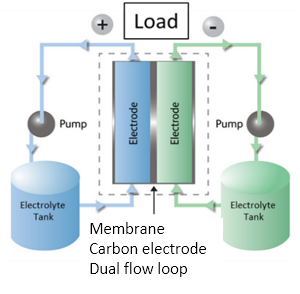
Conventional flow batteries contain two electrolyte solutions in two separate tanks, circulated through two independent loops, separated by a membrane and energy is stored chemically in the electrolyte tank. Source: Primus Power
While solid-state batteries such as lithium ion store energy in solid electrode material like metal, flow batteries store energy in electrolyte liquids.
Most conventional flow batteries use two electrolyte liquids: one with a negatively charged cathode, and one with a positively charged anode. The cathode and anode are separated into two tanks by a membrane, because if they come into contact with each other the battery will short and require replacement. This is often what happens with lithium-ion batteries; the membrane degrades over time. But the exchange of negatively and positively charged fluids in flow batteries produces electrical current without degradation, providing a longer cycle life and quick response times.
While lithium-ion batteries are great for mobile, high-power applications like laptops and cell phones, flow batteries are able to store power for longer periods (four hours or more), and last for decades before needing replacement. This makes them good for providing power to large utility applications, military bases, data centers, microgrids and off-grid projects that are not space-constrained.

Demonstration of redox Source: ESS

Primus Power’s design utilizes a single tank, a single flow loop design and no membrane and energy is stored in a plated metal on the surface of titanium electrodes. Source: Primus Power
Flow battery manufacturers offer a variety of chemistries including vanadium, iron chromium, zinc bromine, zinc iron and more. Flow batteries can also be redox, hybrid and membraneless.
Redox flow batteries employ reduction (a gain of electrons) and oxidation (a loss of electrons) reactions as electrons are transferred in the electrolyte. Energy is stored in the electrolyte, which flows through the battery during charge and discharge.
In true redox flow batteries, energy is stored in the liquid at all times. However, hybrid redox flow batteries store at least some energy in solid metal during charge.
In a membraneless flow battery, the liquids self-separate in one tank.
Though it depends on the chemistry, flow batteries tend to be less reactive and easy to dispose, with no fire risk. They are also often recyclable.





Are they available? Yes – eg https://redtenergy.com/story/solar-mini-grid-for-resort-hotel/ some photos of their case studies.
I don’t know of any for residential applications as they can be quite big and its a relatively new tech for commericalisation, so they are all focussing on grid-scale installations. Maybe one day!
Find out more about flow batteries at the International Flow Battery Forum 2018 to be held in Lausanne, Switzerland 10 – 12 July. We’ll have news about big, medium and tiny size flow batteries.
Photos of actual installations would be very helpful. Is this only commercial or are there residential installations?
Are flow batteries available for residential application?
I enjoyed the article and have developed an interest in energy storage. I am currently in a 6 week solar training school in Harker Heights, Texas, and will be finished 15 December. I have been sending my resumes out, and SolarPowerWorld OnLine has provided me the best source of information.
When I finish 2H Solar, my next venture is education in energy storage. Since I have an interest, my instructor has tasked me with homework to find current commercial or utility-scale solar projects in Texas that are using energy storage.
Can you help? I have called/emailed many EPCs with two previous assignments looking for commercial and utility-scale projects in Texas, but they refuse to provide information as there is customer/client confidentiality. I understand and can relate as I have worked the last 5 years in management, and have guarded proprietary information.
Anyway, if you have past articles, or are aware of future endeavors here in Texas developing or installing energy storage to supplement the PV systems, I can use some help.
The website I entered is not mine but my instructor’s.
Thank you.